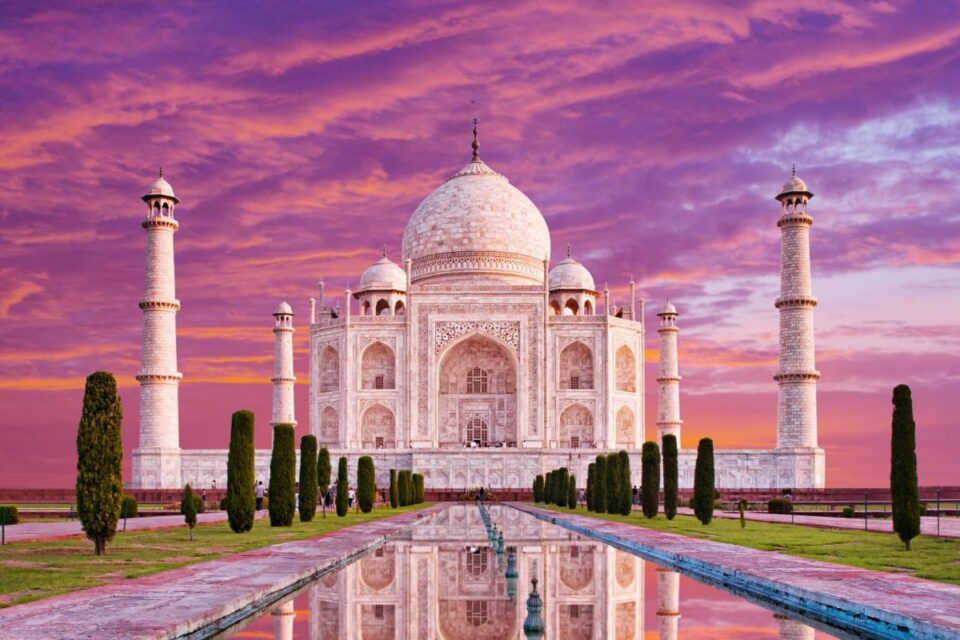The Taj Mahal, one of the Seven Wonders of the World, stands as an eternal symbol of love and an architectural masterpiece. Located in Agra, India, this magnificent white marble mausoleum was commissioned by the Mughal Emperor Shah Jahan in memory of his beloved wife, Mumtaz Mahal. Over the centuries, the Taj Mahal has captivated millions of visitors with its breathtaking beauty and rich history.
A Love Story Etched in Stone
The story behind the Taj Mahal is as enchanting as the monument itself. Shah Jahan, deeply in love with his wife Mumtaz Mahal, was devastated by her untimely death in 1631 during childbirth. To honor her memory and their deep bond, he decided to build a mausoleum that would be unparalleled in grandeur and beauty. The construction of the Taj Mahal began in 1632 and took approximately 22 years to complete, with the efforts of over 20,000 artisans and craftsmen.
Architectural Splendor
The Taj Mahal is a quintessential example of Mughal architecture, which combines elements from Islamic, Persian, Ottoman Turkish, and Indian architectural styles. The central structure, crowned by a large dome, is flanked by four minarets, each standing tall and adding to the monument’s majestic aura. The intricate marble inlay work, featuring semi-precious stones like jade, crystal, lapis lazuli, amethyst, and turquoise, enhances the aesthetic appeal of the edifice.
The symmetry of the Taj Mahal is another striking feature. The mausoleum is set within a sprawling Mughal garden, with reflecting pools and fountains that mirror the beauty of the structure, creating a mesmerizing sight. The carefully planned layout, with its perfectly aligned pathways and lush greenery, adds to the monument’s serene and harmonious atmosphere.
The Intricacies of Design
The interior of the Taj Mahal is as splendid as its exterior. The cenotaphs of Mumtaz Mahal and Shah Jahan lie at the center of the main chamber, surrounded by an exquisitely carved marble screen. Calligraphic inscriptions of Quranic verses adorn the walls, enhancing the spiritual ambiance of the monument. The play of natural light through the finely latticed screens creates a soft, ethereal glow, adding to the overall beauty.
Preservation Efforts
Over the years, the Taj Mahal has faced challenges from pollution, environmental factors, and the sheer number of visitors. To preserve this iconic structure, various conservation efforts have been undertaken. Measures include restricting vehicular traffic near the monument, using mud-pack therapy to clean the marble, and implementing strict regulations to maintain its pristine condition.
A UNESCO World Heritage Site
In 1983, the Taj Mahal was designated a UNESCO World Heritage Site, recognizing its cultural and historical significance. It is not only a testament to the grandeur of Mughal architecture but also a symbol of India’s rich heritage and artistic excellence. The monument attracts millions of tourists from around the globe, making it one of the most visited sites in the world.
The Taj Mahal remains a timeless marvel, a testament to love, and an architectural jewel that continues to inspire awe and admiration. Its exquisite beauty, intricate craftsmanship, and poignant history make it a symbol of India’s rich cultural legacy. A visit to the Taj Mahal is a journey through time, offering a glimpse into the grandeur of the Mughal era and the enduring power of love.


9 comments
Your point of view caught my eye and was very interesting. Thanks. I have a question for you.
Your article helped me a lot, is there any more related content? Thanks!
This blog is definitely rather handy since I’m at the moment creating an internet floral website – although I am only starting out therefore it’s really fairly small, nothing like this site. Can link to a few of the posts here as they are quite. Thanks much. Zoey Olsen
What¦s Taking place i am new to this, I stumbled upon this I have found It positively helpful and it has aided me out loads. I’m hoping to give a contribution & aid other customers like its helped me. Great job.
Equity release solutions may provide the financial freedom you’ve been looking for. Learn how to use the equity tied up in your home without having to downsize.
Excellent blog right here! Also your website loads up very fast! What web host are you using? Can I get your affiliate hyperlink for your host? I want my site loaded up as quickly as yours lol
Excellent post. I was checking constantly this weblog and I am impressed! Extremely useful info particularly the remaining section 🙂 I deal with such information much. I used to be seeking this particular info for a long time. Thanks and good luck.
Thank you for your sharing. I am worried that I lack creative ideas. It is your article that makes me full of hope. Thank you. But, I have a question, can you help me?
Howdy! This post couldn’t be written any better! Reading through this post reminds me of my good old room mate! He always kept talking about this. I will forward this article to him. Pretty sure he will have a good read. Thanks for sharing!